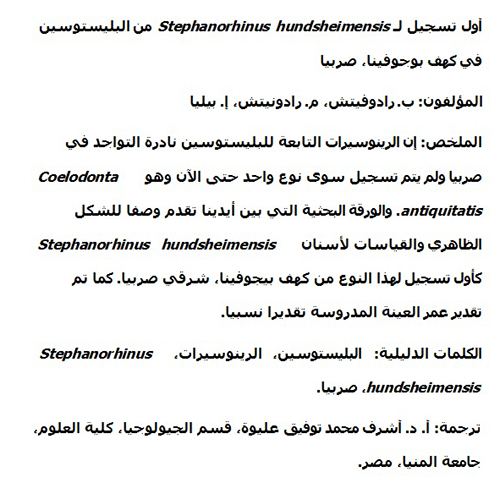Pleistocene rhinoceros from Bogovina Cave: The first report of Stephanorhinus hundsheimensis Toula, 1902 (Mammalia, Rhinocerotidae) from Serbia
Plain Language Abstract
The paper presents a small collection of fossil teeth ascribed to the Pleistocene tandem-horned rhinoceros Stephanorhinus hundsheimensis Toula, 1902 which originated from the Bogovina Cave [Bogovinska pećina] situated near the town of Boljevac in eastern Serbia (43°53'49" N, 21°55'31" E). A small number of equid and bovid teeth were also recovered from the same site. Unfortunately, the primary geological context of the fossils could not be determined, as it is often the case with finds of Pleistocene rhinoceros. Nevertheless, the fossil material from Bogovina Cave is important due to the fact that it represents the first find of S. hundsheimensis in Serbia and only the second from the territory of former Yugoslavia. The sole previously known Pleistocene rhinoceros species coming from Serbia was the woolly rhinoceros, Coelodonta antiquitatis Blumenbach, 1799.
Resumen en Español
Rinocerontes pleistocenos de la Cueva Bogovina: el primer registro de Stephanorhinus hundsheimensis Toula, 1902 (Mammalia, Rhinocerotidae) de Serbia
Los hallazgos de rinocerontes pleistocenos son raros en Serbia, y hasta el momento solamente se registró una especie (el rinoceronte lanudo Coelodonta antiquitatis Blumenbach, 1799). El presente trabajo incluye material de dientes del rinoceronte extinto apodado Hundsheim, Stephanorhinus hundsheimensis Toula, 1902 de la Cueva Bogovina (Serbia oriental). Tanto las características morfológicas como las métricas de los dientes son consistentes con la atribución a S. hundsheimensis. Desafortunadamente, el material tiene un contexto geológico incierto, por lo que no hay base firme para una datación. Sin embargo, la asociación potencial con un diente de caballo caballoide podría evidenciar una edad de 600 ka o menos para la asociación, lo cual podría indicar una fecha tardía relativa para el rinoceronte Hundsheim de la Cueva Bogovina.
Palabras clave: Pleistoceno, rinoceronte, Stephanorhinus hundsheimensis, Serbia
Traducción: Diana Elizabeth Fernández
Résumé en Français
Les rhinocéros pléistocènes de la grotte de Bogovina : première étude des Stephanorhinus hundsheimensis Toula, 1902 (Mammalia, Rhinocerotidae) de Serbie
Les découvertes de rhinocéros pléistocènes sont rares en Serbie, et seule une espèce (le rhinocéros laineux Coelodonta antiquitatis Blumenbach, 1799) a été signalée jusqu’à présent. Cet article présente le matériel dentaire du rhinocéros éteint Stephanorhinus hundsheimensis (Toula, 1902), surnommé le rhinocéros de Hundsheim, provenant de la grotte de Bogovina (Serbie orientale). Les caractéristiques morphologiques et métriques des dents sont cohérentes avec l’attribution à S. hundsheimensis. Malheureusement, le matériel de rhinocéros provient d’un contexte géologique incertain, et il n’y a donc pas de base solide pour proposer une datation. Cependant, une association potentielle avec un cheval caballoïde pourrait suggérer un âge de 600 ka ou moins pour l’assemblage, ce qui indiquerait une date relativement récente pour le rhinocéros de Hundsheim de la grotte de Bogovina.
Mots-clés : Pléistocène ; rhinocéros ; Stephanorhinus hundsheimensis ; Serbie
Translator: Antoine Souron
Deutsche Zusammenfassung
Ein pleistozänes Nashorn aus der Bogovina Höhle: der erste Nachweis von Stephanorhinus hundsheimensis Toula, 1902 (Mammalia, Rhinocerotidae) aus Serbien
Nashornfunde aus dem Pleistozän sind in Serbien selten und es wurde bisher nur über eine Art (das Wollnashorn Coelodonta antiquitatis Blumenbach, 1799) berichtet. Die vorliegende Arbeit stellt das Zahnmaterial des ausgestorbenen sogenannten Hundsheim Nashorns, Stephanorhinus hundsheimensis (Toula, 1902) aus der Bogovina Höhle (Ostserbien) vor. Sowohl die morphologischen als auch die metrischen Merkmale der Zähne sind konsistent mit der Zuordnung zu S. hundsheimensis. Leider stammte das Nashornmaterial aus einem unsicheren geologischen Kontext, so dass es keine feste Grundlage für eine Datierung gibt. Eine mögliche Assoziation mit einem caballoiden Pferdezahn könnte jedoch auf ein Alter der Assemblage von 600 ka oder weniger hindeuten, was für ein relativ spätes Vorkommen des Hundsheimer Nashorns aus der Bogovina-Höhle sprechen würde.
Schlüsselwörter: Pleistozän, Nashorn, Stephanorhinus hundsheimensis, Serbien
Translator: Eva Gebauer
Arabic

Translator: Ashraf M.T. Elewa
Polski
Plejstoceński nosorożec z Jaskini Bogovina: pierwsze wystąpienie Stephanorhinus hundsheimensis Toula, 1902 (Mammalia, Rhinocerotidae) w Serbii
Znaleziska plejstoceńskich nosorożców są rzadkie w Serbii; jak dotychczas potwierdzono występowanie tylko jednego gatunku (nosorożca włochatego Coelodonta antiquitatis Blumenbach, 1799). Niniejszy artykuł przedstawia materiał zębowy wymarłego nosorożca Hundheima, Stephanorhinus hundsheimensis Toula, 1902 z Jaskini Bogovina (wschodnia Serbia). Zarówno morfologia jak i parametry zębów pozwalają na ich zaliczenie do S. hundsheimensis. Niestety, badany materiał został znaleziony w niejasnej pozycji w profilu geologicznym, co utrudnia jego datowanie. Niemniej, prawdopodobny związek z zębem konia właściwego może sugerować wiek około 600 ka lub poniżej dla badanego zespołu skamieniałości, co z kolei wskazywałoby na stosunkowo późny wiek nosorożca Hundsheima z Jaskini Bogovina.
Słowa kluczowe: Plejstocen, nosorożec, Stephanorhinus hundsheimensis, Serbia
Translator: Anna Żylińska
Russian
Плейстоценовый носорог из пещеры Боговина: первое сообщение о Stephanorhinus hundsheimensis Toula, 1902 (Mammalia, Rhinocerotidae) из Сербии
Находки ископаемых остатков плейстоценовых носорогов на территории Сербии редки. До сих пор сообщалось только об одном виде (шерстистый носорог Coelodonta antiquitatis Blumenbach, 1799). В статье представлено описание одонтологического материала по вымершему хундсхаймскому носорогу, Stephanorhinus hundsheimensis Toula, 1902 из пещеры Боговина (Восточная Сербия). Как морфологические, так и метрические характеристики зубов согласуются с их принадлежностью S. hundsheimensis. К сожалению, геологический контекст исследуемого материала не был определён, поэтому нет оснований для точной датировки. Тем не менее, обнаружение неподалеку от места находка зуба кабаллоидной лошади указывает на возраст около 600 тыс. лет. Такая датировка указывала бы на относительно позднее появление хундсхаймского носорога из пещеры Боговина.
Ключевые слова: плейстоцен, носорог, Stephanorhinus hundsheimensis, Сербия.
Translator: Oleksandr Kovalchuk
Ukrainian
Плейстоценовий носоріг із печери Боговіна: перше повідомлення про Stephanorhinus hundsheimensis Toula, 1902 (Mammalia, Rhinocerotidae) із Сербії
Знахідки викопних решток плейстоценових носорогів на території Сербії рідкісні. Досі повідомлялося тільки про один вид (шерстистий носоріг Coelodonta antiquitatis Blumenbach, 1799). У статті представлено опис одонтологічного матеріалу по вимерлому хундсхаймскому носорогу, Stephanorhinus hundsheimensis Toula, 1902 з печери Боговіна (Східна Сербія). Як морфологічні, так і метричні характеристики зубів узгоджуються з їх приналежністю S. hundsheimensis. На жаль, геологічний контекст досліджуваного матеріалу не був визначений, тому немає підстав для точного датування. Проте, виявлення неподалік від місця знахідки зуба кабалоїдного коні вказує на вік близько 600 тис. років. Таке датування вказувало б на відносно пізню появу хундсхаймского носорога з печери Боговіна.
Ключові слова: плейстоцен, носоріг, Stephanorhinus hundsheimensis, Сербія.
Translator: Oleksandr Kovalchuk

